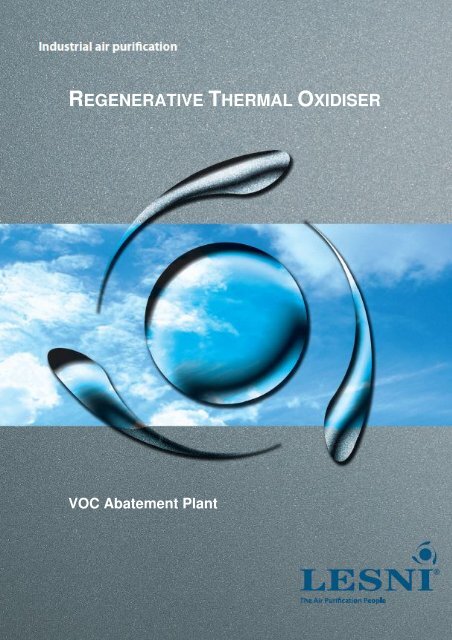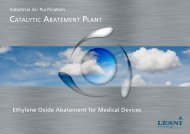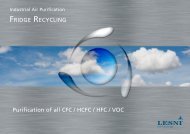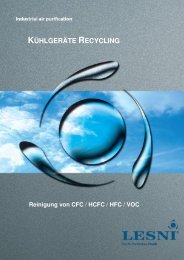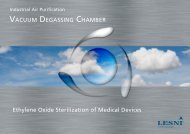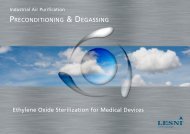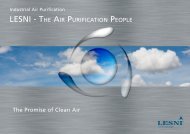Regenerative Thermische Nachverbrennungsanlage (RNV / RTO)
You also want an ePaper? Increase the reach of your titles
YUMPU automatically turns print PDFs into web optimized ePapers that Google loves.
REGENERATIVE THERMAL OXIDISER<br />
VOC Abatement Plant
General Description<br />
The <strong>Regenerative</strong> Oxidiser Plant type REF is an abatement plant, which is<br />
installed to clean waste air emission from processes by means of thermal<br />
oxidation (combustion) of the airborne organic pollutants.<br />
The pollutants are thermally oxidised between 800 – 900 ºC. The temperature<br />
is determined with the type and composition of pollutants, because the<br />
temperature of conversion varies from one pollutant to another.<br />
Under such conditions where pollutants molecules are composed of carbon,<br />
hydrogen and oxygen (C, H and O), these pollutants will be converted to<br />
carbon dioxide (CO 2 ) and water vapour (H 2 0).<br />
The LESNI <strong>Regenerative</strong> thermal oxidiser is always adjusted to the relevant<br />
needs. The REF plants are designed in that way, that once pollutants inlet<br />
concentration are near 2.0 g/m 3 organic carbon, the REF plant can reach auto<br />
thermal conditions.<br />
The REF plant main sections are:<br />
• Three heat recovery reaction chambers<br />
• One combustion chamber<br />
• Three inlet/outlet chambers.<br />
• Proprietary disc valve system.<br />
In the combustion chamber is installed a burner system with gas as fuel. The<br />
burner system is used as pre start heating up and as supply in periods with<br />
little or no inlet concentrations.<br />
Every reaction chamber is filled with ceramic media and the inlet / outlet<br />
chambers are connected to air duct system with valves. The inlet air is lead<br />
through the plant by means of a fan.<br />
The valve system is controlling the change of airflow directions through the<br />
reactions chambers. By means of this change of airflow directions through the<br />
reactors, the ceramic media in the three chambers is caused to respectively<br />
retain and release the heat from / to the air.<br />
2
Function<br />
The LESNI A/S <strong>RTO</strong> Plant type REF is controlled and supervised from a PLC<br />
system, from where the plant is also operated.<br />
Main functions are:<br />
The necessary energy for maintaining the airflow through the plant, is<br />
delivered by the main fan, which is placed on the outlet of the plant, hence<br />
the reactor is working in negative pressure.<br />
The airflow is lead to the valves into the inlet chamber and from there up<br />
through 1 st reaction chamber, where the air receives the energy from the<br />
heated ceramic mass and into the combustion chamber, where if necessary it<br />
receives energy from the gas burner. From here the airflow is lead down<br />
through the 2 nd reaction chamber, where it gives the energy to the ceramic<br />
mass, and then through to the stack. During this period the 3 rd reaction<br />
chamber is purged with some air, which in turn is sent back to 1 st reaction<br />
chamber to be purified again (see picture cycle 1).<br />
3
The same principle of operation is then used in rotating sequence of chambers<br />
/ canisters for cycle 2 and cycle 3 (see picture cycle 2 and cycle3).<br />
4
The LESNI <strong>Regenerative</strong> Thermal Oxidiser; type REF has a bypass function,<br />
where the unclean air is lead directly to stack, bypassing the hot oxidiser for<br />
safety and maintenance.<br />
The temperature of the plant is controlled by regulation valve in the gas<br />
burner system. The free to run condition of the REF is achieved when the set<br />
point temperature in the combustion chamber is reached.<br />
All the valves of the plant are pneumatically operated. That is why, the supply<br />
of compressed air is continuously supervised and when it fails, the REF plant<br />
will shut down. The plant is delivered with an accumulation tank for<br />
compressed air to secure, that when failure occurs, sufficient capacity is<br />
available to shift all the valves and the plant into bypass position.<br />
5
References<br />
Plastic Printing Industry<br />
Solvents - 40.000 Nm³/h<br />
Wood-Working Industry<br />
Solvents - 20.000 Nm³/h<br />
6
Rendering Industry<br />
Odour - 60.000 Nm³/h<br />
Food Industry<br />
Odour - 60.000 Nm³/h<br />
7
8


